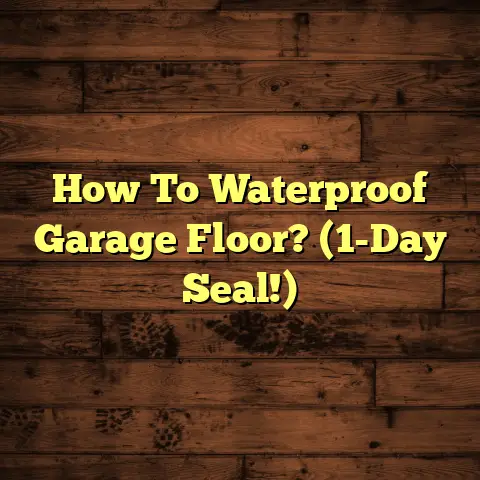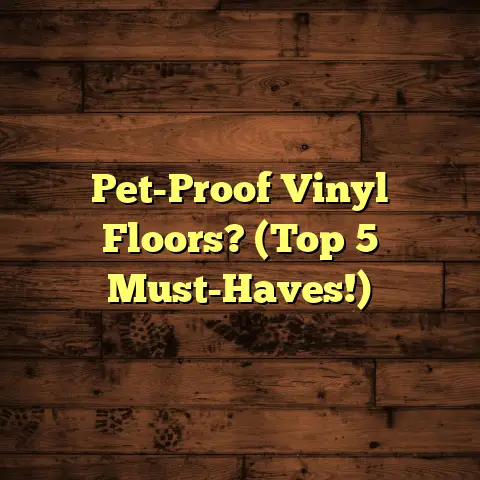Clean Wood Floors Naturally? (5 Pro Secrets!)
Remember that feeling of walking into Grandma’s house?
The smell of lemon and beeswax, and the warm glow of the sun reflecting off her perfectly polished wood floors?
It wasn’t just clean; it felt like home.
That’s the kind of feeling I chase every day as a flooring contractor, and trust me, you can achieve it too, naturally!
Section 1: Understanding Wood Floors
Okay, let’s talk wood.
Not all wood floors are created equal, and knowing the difference is crucial.
As a flooring contractor with years of experience, I’ve seen it all.
Solid Hardwood: The classic.
Think oak, maple, walnut.
It’s one piece of wood, durable, and can be refinished multiple times.
The downside?
It’s more susceptible to moisture damage.Engineered Wood: Layers of wood bonded together with a hardwood veneer on top.
More stable than solid wood, meaning it handles humidity swings better.
Perfect for basements or kitchens.Laminate: Not actually wood!
It’s a photographic image of wood on top of a composite core.
Affordable, durable, but can’t be refinished.
Wood floors are popular for a reason.
They’re beautiful, add value to your home, and can last for generations.
According to the National Wood Flooring Association (NWFA), homes with hardwood floors often sell for higher prices and faster than those without.
But here’s the rub: Keeping them clean can be tricky.
Harsh chemicals can strip the finish, dull the shine, and even damage the wood itself.
That’s where natural cleaning comes in!
Section 2: The Benefits of Natural Cleaning Methods
Why go natural? I get asked this all the time. For me, it’s simple:
Health: Commercial cleaners are often packed with chemicals like phthalates, perchloroethylene, and triclosan, which have been linked to health issues.
Natural cleaners are gentler and safer for your family and pets.Environment: Harsh chemicals end up in our waterways.
Natural cleaners are biodegradable and less harmful to the planet.Effectiveness: Don’t think natural means weak!
Vinegar, baking soda, and essential oils are powerful cleaning agents.Preservation: Natural methods are less likely to damage the finish of your wood floors.
I’ve seen too many floors ruined by harsh chemicals.
I remember a client, Mrs. Peterson, who had beautiful original hardwood floors in her 1920s bungalow.
She’d been using a popular commercial cleaner, and the floors were looking dull and lifeless.
After switching to a natural vinegar solution, the floors regained their shine, and Mrs. Peterson was thrilled!
She even told me her allergies improved.
Section 3: Pro Secret #1 – The Power of Vinegar
Vinegar is my go-to for everyday cleaning.
It’s a natural disinfectant and degreaser.
The acetic acid in vinegar kills bacteria and helps remove dirt and grime.
Here’s my recipe for a vinegar-based wood floor cleaner:
- 1/2 cup white vinegar
- 1 gallon warm water
Important: Always test the solution in an inconspicuous area first to ensure it doesn’t damage the finish.
Application:
- Sweep or vacuum: Remove loose dirt and debris.
- Damp mop: Use a microfiber mop. These mops are gentle and effective.
- Wring out the mop: You want the mop to be damp, not soaking wet.
Excess water can damage wood floors. - Mop in the direction of the wood grain: This helps prevent streaks.
- Dry with a clean microfiber cloth: This helps prevent water spots.
I’ve found that the vinegar smell dissipates quickly, but if you’re sensitive to it, add a few drops of your favorite essential oil (see Pro Secret #2!).
Section 4: Pro Secret #2 – Essential Oils for Freshness
Essential oils aren’t just for aromatherapy; they can also boost your cleaning power and leave your floors smelling amazing!
Safe Essential Oils for Wood Floors:
- Lemon: Cleans, disinfects, and leaves a fresh, citrusy scent.
- Tea Tree: Antibacterial and antifungal. Great for bathrooms and kitchens.
- Lavender: Calming scent and mild disinfectant.
- Orange: Degreases and adds a cheerful aroma.
My Essential Oil Wood Floor Cleaner Recipe:
- 1/2 cup white vinegar
- 1 gallon warm water
- 10-15 drops of your favorite essential oil
Important: Some essential oils can be irritating to pets.
Always do your research before using them around animals.
I once had a client who was struggling with pet odors on her wood floors.
I recommended adding tea tree and lavender essential oils to her cleaning solution.
The combination not only eliminated the odors but also created a relaxing atmosphere in her home.
Section 5: Pro Secret #3 – Baking Soda for Stains
Stains happen.
Pet accidents, food spills, muddy footprints – I’ve seen it all!
Baking soda is my secret weapon for tackling tough stains and odors.
Baking soda is a mild abrasive and a natural deodorizer.
It can lift stains without damaging the wood finish.
Baking Soda Stain Removal Method:
- Make a paste: Mix baking soda with a small amount of water to form a thick paste.
- Apply to the stain: Gently rub the paste onto the stain.
- Let it sit: Allow the paste to sit for 15-30 minutes.
- Wipe away: Wipe away the paste with a damp cloth.
- Dry: Dry the area with a clean cloth.
Case Studies:
Pet Accidents: I had a client whose dog had an accident on her hardwood floor.
The urine had left a dark stain and a lingering odor.
I recommended using a baking soda paste, and it worked like a charm!
The stain disappeared, and the odor was gone.Food Spills: Red wine spills can be a nightmare.
I’ve found that a baking soda paste can help lift the stain if applied quickly.
Important: Always test the baking soda paste in an inconspicuous area first to ensure it doesn’t damage the finish.
Section 6: Pro Secret #4 – Olive Oil and Vinegar Polish
Want to give your wood floors a natural shine?
Try this olive oil and vinegar polish.
Olive oil moisturizes the wood, while vinegar cuts through grime and helps remove streaks.
Olive Oil and Vinegar Polish Recipe:
- 1/2 cup olive oil
- 1/2 cup white vinegar
- 1 cup warm water
Application:
- Mix the ingredients: Combine the olive oil, vinegar, and water in a spray bottle.
- Spray lightly: Lightly spray the polish onto the floor.
- Buff: Use a clean microfiber cloth to buff the floor in the direction of the wood grain.
Important: Use this polish sparingly. Too much olive oil can make the floor slippery.
I recommend using this polish once a month to maintain the floor’s luster and extend its lifespan.
It’s a simple, natural way to keep your wood floors looking their best.
Section 7: Pro Secret #5 – Regular Maintenance Routines
The key to beautiful wood floors is regular maintenance.
Don’t wait until your floors are filthy to clean them.
Cleaning Schedule:
- Daily: Sweep or vacuum to remove loose dirt and debris.
- Weekly: Damp mop with a vinegar solution.
- Monthly: Polish with olive oil and vinegar.
Preventative Measures:
- Rugs: Use rugs in high-traffic areas to protect the floors from scratches and wear.
- Furniture Pads: Place furniture pads under the legs of furniture to prevent scratches.
- Doormats: Use doormats at entrances to trap dirt and debris.
- No Shoes: Encourage family and guests to remove their shoes.
I always tell my clients that preventative maintenance is the best investment they can make in their wood floors.
A little effort goes a long way in preserving their beauty and extending their lifespan.
Conclusion:
Remember that feeling of walking into Grandma’s house?
The warmth, the cleanliness, the sense of home?
You can create that same feeling in your own home with these five pro secrets.
Natural cleaning is not only better for your health and the environment, but it’s also the best way to preserve the beauty of your wood floors.
Embrace the process of cleaning as a way to connect with your space and create a warm, inviting home for yourself and your loved ones.
So, grab your vinegar, essential oils, and baking soda, and get ready to transform your wood floors!
You’ll be amazed at the results.





